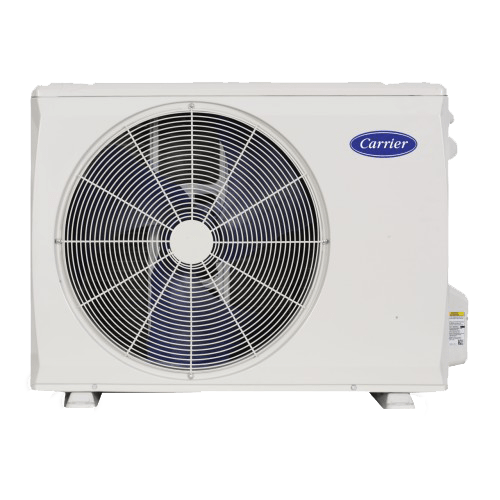Ductless Mini Split Installation Costs in 2025
By Ryan Mayes

HOW MUCH DOES A DUCTLESS MINI SPLIT COST?
Mini split installation costs typically range from $2,000 to $10,500. Ductless mini split system cost fluctuates based on a number of factors, including the local market, condition of the home and area climate. Ductless mini split system cost also depends upon the type of system. Carrier® ductless AC systems, for example, offer a variety of energy efficiency or SEER2* ratings, various types of installation options, and even multi-room installations if you go with a multi-zone heat pump.
The good news is there are a number of ways to make ductless mini-split prices more manageable that benefit you in the long run. These include promotional rebates available during select times of year as well as utility company rebates, financing options through your dealer, lease-to-own options, and savings on energy costs over time. Because there is no ductwork to install, the average cost of mini split installation is typically less than installing a central HVAC system, even though both systems include both outdoor and indoor units.
To find out more, check out our dedicated rebate and HVAC financing web pages. Additionally, explore the differences between ductless mini split vs central air to make an informed decision.
Factors That Influence DUCTLESS MINI SPLIT AC INSTALLATION COST
Factors that can affect your ductless AC cost include:
- Size of your room/home
- Energy efficiency & quality of ductless system
- Capacity of your outdoor condensing unit
- Complexity of installation
Size of Your Home
One of the more important considerations for determining ductless is the size of the room or home you are trying to cool. Ductless single zone air conditioners often have a cooling capacity that ranges from ¾-ton units up to 2-ton models.
When discussing ductless mini split installation costs, it's helpful to understand a few key terms: tons refer to the cooling capacity of the system, with one ton equal to 12,000 BTUs (British Thermal Units), which measure how much heat the unit can remove per hour. Zones refer to individual areas or rooms that the system can heat or cool independently—more zones generally increase installation cost but offer better temperature control throughout the home. Learn more about single zone vs multi zone ductless systems.
While there are formulas available to help you estimate the right sized ductless AC unit for your space, the easiest and most accurate method is to rely on a Carrier® HVAC dealer. They’ll be able to provide an accurate assessment of the right-sized equipment for your home. Learn more about how big of a mini split do I need?
For cooling an entire home, you might consider a multi-zone ductless heat pump with one outdoor unit that can support 2-5 indoor units and supply up to 4 tons of heating and cooling capacity.
As you might expect, the single room options will vary a little in price based on cooling capacity, but the multi-zone system with multiple indoor units will cost quite a bit more due to the cost of the additional indoor units, additional wiring and copper tubing to install them, and the additional labor costs as well.
Energy Efficiency & Quality of Ductless System
As is the case with a traditional central AC system, ductless AC costs can vary based on the efficiency rating, cooling capacity, and any additional comfort benefits. First, let’s define the energy efficiency ratings and cooling capacities, then we’ll talk about their influence on pricing.
SEER2 rating: SEER2 is an acronym for Seasonal Energy Efficiency Ratio 2 and is a measure of how much energy the system uses during the entire season to cool your home during that same time frame. Much like miles-per-gallon for your car represents fuel efficiency, the higher the SEER2 rating, the higher the energy efficiency and savings.
EER2 rating : EER2 is short for Energy Efficiency Ratio 2, and is another standard measure of an air conditioner’s efficiency. Instead of providing a picture of how efficient the system is over an entire cooling system, EER2 is the amount of cooling capacity delivered divided by the amount of energy (in watts) it takes to generate that amount of cooling.
HSPF2 rating: HSPF2 is an acronym for Heating Seasonal Performance Factor and is a measure of the heating efficiency of a heat pump. The higher the HSPF2 number, the more efficiently the heat pump heats your home. While we have been mainly talking about ductless AC units, many of Carrier’s ductless systems work as a heat pump too.
Capacity of Outdoor Condenser
Ductless mini split air conditioning systems include an outdoor condenser unit and one or more indoor air handlers. A single-zone system provides comfort to one room or area, and includes one outdoor unit and one indoor unit. These systems are available at lower cooling capacities, between ¾-ton systems and up to 5-ton versions.
Multi-zone systems can provide separate comfort control in several areas. Carrier offers this capability with its multi-zone ductless heat pump that provides both heating and cooling and can be combined with 2 – 5 indoor units. This system offers a higher combined heating and cooling capacity, up to 4 tons, to support the additional indoor units and to deliver comfort to more square footage.
Complexity of Installation
When you discuss ductless AC prices with an HVAC contractor, be aware that the installation location and accessibility can impact the overall cost. Some examples include:
- High wall installation vs. in-ceiling: Installing a high wall indoor unit will likely cost a little less than an in-ceiling cassette unit that may require the contractor to create an opening in the ceiling during installation.
- Long refrigerant lines: One advantage of ductless systems is that there can be a longer distance between the indoor and outdoor units. One disadvantage is the longer the distance, the more material cost for copper tubing and most likely more labor costs as well. For example, installing an indoor unit on a 2nd or 3rd floor when the outdoor unit is at the ground level.
- New installation vs. replacement: New installations will often require the contractor to drill through walls or floors to run the copper refrigerant tubing and electrical wiring that connects the indoor and outdoor units. When replacing older equipment, some of this prep work is already done and can speed up the installation for a little money savings.
3 Ways to Save on Mini Split Installation Costs
Installing a ductless mini split heat pump system can be a significant expense. While the prospect of a DIY ductless mini split installation might seem tempting, we strongly advise entrusting this task to your local expert. If you're working within a budget and looking to minimize costs for upgrading your home's cooling system, explore various strategies to reduce the expenses associated with a ductless mini split installation.
1. Choose the right time
2. Consider Rebates and Tax Credits
3. Get Multiple Quotes
TALK TO A PROFESSIONAL ABOUT YOUR DUCTLESS AC NEEDS
It's important to consult with a qualified ductless mini split professional to assess the unique requirements of the space, discuss comfort preferences, and receive a personalized quote for the right ductless mini split system for you, as every installation job is distinct and tailored to the homeowner's needs. Schedule an appointment with your local Carrier ductless mini split expert today and get ready to enjoy ductless AC comfort.
Frequently Asked Questions About Ductless Mini Split Cost
Explore Carrier Ductless Air Conditioners
A Carrier ductless air conditioner offers flexible, energy-efficient cooling without the need for extensive ductwork, making it ideal for homes with limited space or existing duct systems. With precise temperature control for individual rooms or zones, it ensures personalized comfort and can lead to lower heating and cooling costs. Additionally, Carrier's ductless systems are designed for quiet operation and easy installation, providing an effective and discreet heating and cooling solution. Explore Carrier's line of ductless air conditioners today.
Single-zone system with up to 35.1 SEER2 and 30 HSPF2 for premium energy savings.
Single-zone system with up to 26 SEER2 and 13.9 HSPF2 for premium energy savings.
Learn More About Ductless AC
- Learn about mini split repairs
- Find out more about ductless AC maintenance
- Explore how long do mini splits last?
- Discover mini split pros and cons
- Discover ductless mini splits for garage
- Learn about the different types of ductless heating and cooling system types








